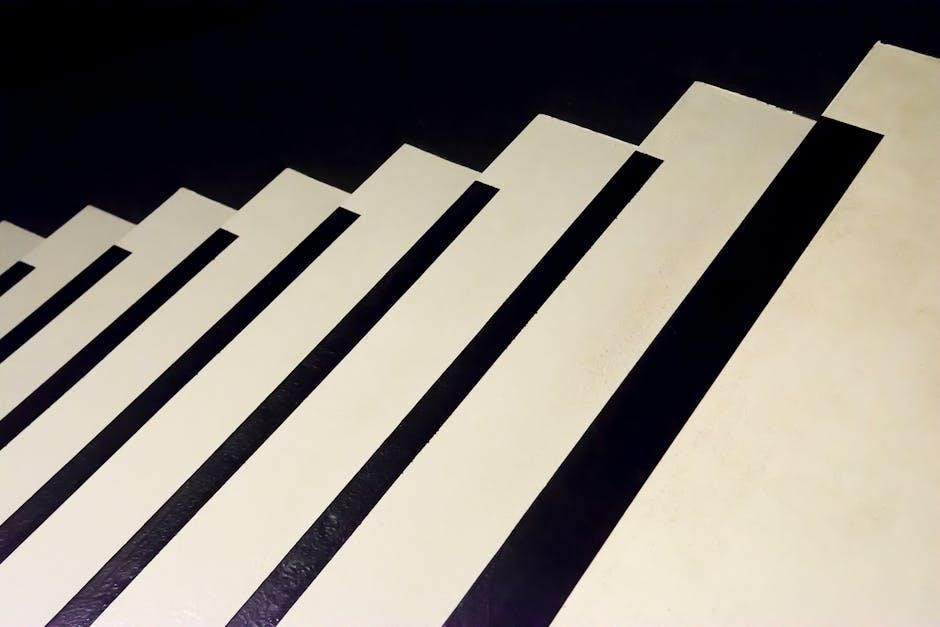The Angle Addition Postulate states that the sum of two adjacent angles equals the measure of the larger angle they form, aiding in solving geometric problems with real-world applications.
What is the Angle Addition Postulate?
The Angle Addition Postulate is a fundamental geometric principle that states if two angles are adjacent, sharing a common vertex and a common side, the sum of their measures equals the measure of the larger angle formed. For instance, if two angles measure 30° and 45°, their sum is 75°, which is the measure of the larger angle they form together. This postulate applies to any adjacent angles, regardless of their specific measures, and is a foundational concept used in solving various geometric problems, from simple angle calculations to more complex constructions in architecture and engineering. By understanding this postulate, one can better grasp how angles relate in forming larger geometric figures and solve problems more effectively. It is essential for progressing in geometry, as it underpins more advanced principles and practical applications in fields like construction and design.

Key Definitions and Concepts
Adjacent angles share a common vertex and side, forming a larger angle whose measure equals the sum of the smaller angles, as per the postulate.
Adjacent Angles and Common Vertices
Adjacent angles are two angles that share a common vertex and a common side, forming a larger angle when combined. These angles do not overlap but align at their vertex and side, creating a straight or curved formation. The Angle Addition Postulate applies to such angles, stating their sum equals the measure of the larger angle formed. This concept is fundamental in geometry, enabling the calculation of unknown angles in various figures, such as triangles or polygons, by leveraging the relationship between adjacent angles and their shared vertex.
How to Use the Postulate with Worksheets
Use worksheets to practice applying the Angle Addition Postulate by identifying adjacent angles, calculating their sum, and solving for missing angle measures in geometric problems.
Finding Missing Angles
To find missing angles using the Angle Addition Postulate, identify adjacent angles sharing a common vertex and side. Add their measures to determine the larger angle formed. For example, if two adjacent angles measure 40° and 60°, their sum is 100°, which equals the measure of the larger angle; Use algebraic expressions to solve for unknown angles by setting up equations based on the postulate. Verify solutions by ensuring the sum of smaller angles matches the larger angle. Practice with worksheets to reinforce understanding and apply real-world problem-solving skills effectively. Step-by-step examples and answer keys provide guidance and confirmation of correct solutions.
Sample Problems and Solutions
Problem: Find mKLM if mKLB = 26° and mBLM = 60°. Solution: mKLM = mKLB + mBLM = 26° + 60° = 86°.
Step-by-Step Examples
Problem: Find m∠KLM if m∠KLB = 26° and m∠BLM = 60°.
Solution:
Identify adjacent angles: ∠KLB and ∠BLM.
Apply the Angle Addition Postulate: m∠KLM = m∠KLB + m∠BLM.
Calculate: m∠KLM = 26° + 60° = 86°.
Another example: If two angles around a point sum to 180°, the third angle can be found by subtracting their sum from 180°. This method ensures accurate angle measurement in various geometric problems, aligning with real-world applications like measuring land corners or construction layouts.
Key takeaway: Use the postulate to simplify complex angle problems by breaking them into manageable parts.

Real-World Applications
The Angle Addition Postulate is essential in construction, landscaping, and engineering, helping professionals measure and design precise angles for buildings, roads, and structural layouts efficiently.
Geometry in Everyday Scenarios
The Angle Addition Postulate is vital in real-world applications like construction, where precise angles ensure structural integrity. Landscapers use it to design symmetric gardens, while engineers apply it in bridge construction for stability. Architects leverage the postulate to create balanced building designs, ensuring aesthetic and functional spaces. It also aids in smaller projects, such as installing shelves or planning room layouts, by helping visualize and calculate spatial arrangements. This practical tool bridges geometry concepts with everyday problem-solving, making it indispensable in various professions and DIY endeavors.

Related Geometry Properties
Complementary angles sum to 90°, while supplementary angles sum to 180°, both essential in applying the Angle Addition Postulate for solving various geometric problems effectively.
Complementary and Supplementary Angles
Complementary angles sum to 90°, while supplementary angles sum to 180°. These properties are foundational in geometry, often used alongside the Angle Addition Postulate to solve problems. For example, if two angles are complementary, their measures add up to a right angle, aiding in calculations involving adjacent angles. Supplementary angles, on the other hand, form a straight line when combined. Understanding these concepts enhances problem-solving skills in geometry, particularly when dealing with adjacent angles and their sums. They are essential for mastering various geometric principles and real-world applications.
Step-by-Step Guide to Solving Problems
Identify adjacent angles, apply the Angle Addition Postulate, and solve for unknowns using algebraic expressions. Verify solutions by ensuring the sum matches the larger angle formed.
Using Algebraic Expressions
When solving problems with the Angle Addition Postulate, set up equations where the sum of two adjacent angles equals the larger angle. Use variables to represent unknowns and solve algebraically. For example, if angle A + angle B = angle C, express angle C as the sum of A and B. Substitute known values and solve for the unknown; Verify solutions by ensuring the sum matches the larger angle. This method is effective for finding missing angles in triangles, polygons, or real-world scenarios, making algebra a powerful tool in geometric problem-solving.
Common Mistakes to Avoid
Common mistakes include not verifying if angles are adjacent or misapplying the postulate to non-adjacent angles, leading to incorrect sums. Double-checking configurations is crucial.
Pitfalls in Applying the Postulate
One common mistake is assuming all angles can be added using the postulate without verifying adjacency. Ensure angles share a common vertex and side. Another pitfall is misidentifying supplementary or complementary angles, leading to incorrect sums. Additionally, students often overlook the necessity of visual confirmation, incorrectly adding angles that appear adjacent but are not. Always double-check configurations before applying the postulate. These errors highlight the importance of careful analysis to avoid misleading results and ensure accurate angle measurements in geometric problems.

Resources for Further Practice
- Download PDF worksheets with answers for angle addition problems.
- Visit andymath.com for additional practice materials.
- Explore lesson plans and exercises for mastery of the postulate.
Recommended Worksheets and PDFs
Enhance your understanding with curated worksheets and PDFs.
- Download PDFs with answer keys for self-paced practice.
- Explore lesson plans and exercises for comprehensive learning.
- Utilize workbooks offering varied problems and solutions.
These resources provide structured learning and real-world applications.
Mastering the Angle Addition Postulate is key to solving geometric problems efficiently. Always ensure angles are adjacent and share a common vertex and side before applying the postulate. Regular practice with worksheets and PDF resources will enhance your problem-solving skills and understanding of geometric principles. By consistently applying these concepts, you’ll become proficient in using the Angle Addition Postulate to find missing angles and solve complex geometric problems with accuracy and confidence.
Mastering the Postulate
Mastering the Angle Addition Postulate requires a strong understanding of adjacent angles and their properties. Regular practice with worksheets and PDF answer keys helps reinforce concepts. Start by solving basic problems, gradually increasing difficulty. Use visual aids like diagrams to visualize angle relationships. Apply real-world examples to deepen comprehension. Avoid common mistakes, such as misidentifying non-adjacent angles. Always verify answers with provided keys to ensure accuracy. Over time, this practice will build confidence and proficiency in using the postulate to solve geometric problems efficiently. Consistent effort and review are key to long-term mastery of this fundamental geometric principle.